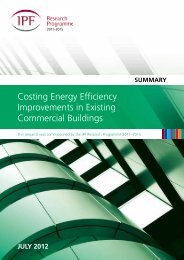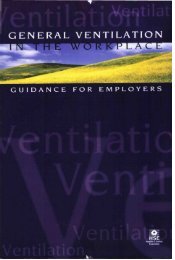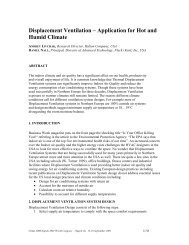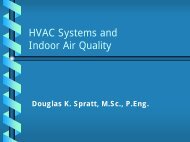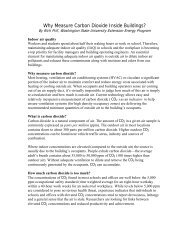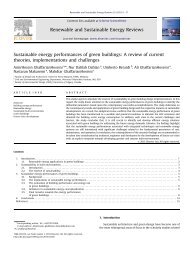Indoor Air Quality and Thermal Comfort in Open-Plan Offices
Indoor Air Quality and Thermal Comfort in Open-Plan Offices
Indoor Air Quality and Thermal Comfort in Open-Plan Offices
You also want an ePaper? Increase the reach of your titles
YUMPU automatically turns print PDFs into web optimized ePapers that Google loves.
National Research Council CanadaHome> Publications> NRC publications> Construction Technology Updates> <strong>Indoor</strong> <strong>Air</strong> <strong>Quality</strong>> <strong>Indoor</strong> Environment> <strong>Indoor</strong> <strong>Air</strong> <strong>Quality</strong> <strong>and</strong> <strong>Thermal</strong> <strong>Comfort</strong> <strong>in</strong> <strong>Open</strong>-<strong>Plan</strong> <strong>Offices</strong><strong>Indoor</strong> <strong>Air</strong> <strong>Quality</strong> <strong>and</strong> <strong>Thermal</strong> <strong>Comfort</strong> <strong>in</strong> <strong>Open</strong>-<strong>Plan</strong> <strong>Offices</strong>Archived ContentInformation identified as archived is provided for reference, research or recordkeep<strong>in</strong>g purposes. It is not subject to the Governmentof Canada Web St<strong>and</strong>ards <strong>and</strong> has not been altered or updated s<strong>in</strong>ce it was archived. Please contact us to request a format otherthan those available.Construction Technology Update No. 64 , October 2005[PDF version]By K. Charles, J.T. Reardon <strong>and</strong> R.J. MageeProvid<strong>in</strong>g good <strong>in</strong>door air quality (IAQ) <strong>and</strong> thermal comfort is important for employee satisfaction, well-be<strong>in</strong>g <strong>and</strong> performance. ThisUpdate provides guidance on key issues for achiev<strong>in</strong>g adequate <strong>in</strong>door air quality <strong>and</strong> thermal comfort <strong>in</strong> open-plan offices, based oncurrent st<strong>and</strong>ards <strong>and</strong> research conducted by NRC's Institute for Research <strong>in</strong> Construction <strong>and</strong> others..<strong>Air</strong> quality <strong>and</strong> thermal conditions <strong>in</strong> open-plan offices are issues that must be addressed by the build<strong>in</strong>g designer, manager <strong>and</strong> owner <strong>in</strong>the design <strong>and</strong> operation of ventilation systems <strong>and</strong> office spaces. Poor air quality <strong>and</strong> thermal conditions can lead to employeedissatisfaction <strong>and</strong> discomfort, a reduction <strong>in</strong> work performance, <strong>and</strong> a greater <strong>in</strong>cidence of absenteeism. Poor conditions can also affectoccupants' health, creat<strong>in</strong>g physical symptoms such as headaches, nose, throat, eye <strong>and</strong> sk<strong>in</strong> irritation, nausea <strong>and</strong> drows<strong>in</strong>ess.Many of the causes of poor IAQ <strong>and</strong> thermal conditions are similar for all types of offices, <strong>and</strong> st<strong>and</strong>ards used <strong>in</strong> North America, such asthose from the American Society of Heat<strong>in</strong>g, Refrigerat<strong>in</strong>g <strong>and</strong> <strong>Air</strong>-Condition<strong>in</strong>g Eng<strong>in</strong>eers (ASHRAE), can help to avoid problems.However, open-plan offices tend to be more densely populated than <strong>in</strong>dividual enclosed offices, a situation which can <strong>in</strong>fluence theamount of heat <strong>and</strong> contam<strong>in</strong>ants produced <strong>in</strong> the space. It is important, therefore, that these factors be taken <strong>in</strong>to account whenapply<strong>in</strong>g st<strong>and</strong>ards <strong>and</strong> recommendations to the design of open-plan offices.The purpose of this Update is to provide guidance on achiev<strong>in</strong>g good IAQ <strong>and</strong> thermal conditions <strong>in</strong> open-plan offices that are <strong>in</strong>mechanically ventilated <strong>and</strong> well-sealed office build<strong>in</strong>gs. The Update <strong>in</strong>cludes recommendations that can be used to <strong>in</strong>crease occupantsatisfaction <strong>and</strong> comfort, <strong>and</strong> reduce physical symptoms. The prevention of more serious health conditions (e.g., asthma, cancer, hyper-
sensitivity) is not addressed. If there is reason to believe that serious health concerns are related to the air quality or thermal conditions<strong>in</strong> the office, an <strong>in</strong>vestigation by medical <strong>and</strong> <strong>in</strong>door environment specialists should be carried out.This Update exp<strong>and</strong>s on Update No. 60, which summarized thef<strong>in</strong>d<strong>in</strong>gs of the Cost-effective <strong>Open</strong>-<strong>Plan</strong> Environments (COPE)project. IRC's partners <strong>in</strong> COPE were: Public Works <strong>and</strong>Government Services Canada, the Build<strong>in</strong>g TechnologyTransfer Forum, USG Corporation, Ontario Realty Corporation,British Columbia Build<strong>in</strong>gs Corporation, Steelcase Incorporated,<strong>and</strong> Natural Resources Canada. For more <strong>in</strong>formation on COPE,see http://www.nrc-cnrc.gc.ca/eng/projects/irc/cope.html.Three related Updates address workstation design, light<strong>in</strong>g<strong>and</strong> acoustics.<strong>Thermal</strong> <strong>Comfort</strong>If temperature <strong>and</strong> humidity levels <strong>in</strong> the office are too high or too low, occupants can be dissatisfied with the environment,uncomfortable <strong>and</strong> less effective <strong>in</strong> their tasks. <strong>Comfort</strong>able conditions <strong>in</strong> mechanically ventilated build<strong>in</strong>gs depend on six variables: airtemperature, air velocity, relative humidity, radiant temperature, occupant's cloth<strong>in</strong>g <strong>in</strong>sulation <strong>and</strong> occupant's activity level. ASHRAE'sSt<strong>and</strong>ard-55 def<strong>in</strong>es a comfort "zone" based on these variables, where the majority of occupants are likely to feel comfortable. 1The higher density of occupants <strong>and</strong> equipment <strong>in</strong> most open-plan offices <strong>in</strong>creases the amount of heat released (<strong>and</strong> thereby thecool<strong>in</strong>g requirements) <strong>in</strong> the space. Thus the heat<strong>in</strong>g/cool<strong>in</strong>g system must have the capacity to h<strong>and</strong>le the occupant density, <strong>and</strong> beoperated appropriately to meet thermal requirements.Accord<strong>in</strong>g to the comfort zone diagrams, 1 comfortable temperatures are almost impossible to achieve when the relative humidity is high.High humidity also supports mould <strong>and</strong> bacterial growth, so ASHRAE recommends that relative humidity be ma<strong>in</strong>ta<strong>in</strong>ed below 60%. Thereis no recommended lower level of humidity for achiev<strong>in</strong>g thermal comfort, but as dry conditions can lead to <strong>in</strong>creased static electricity<strong>and</strong> health problems, such as sk<strong>in</strong> irritation, the relative humidity should be greater than 30%. ASHRAE's acceptable ranges of operativetemperature (a comb<strong>in</strong>ation of air <strong>and</strong> radiant temperatures) for relative humidity levels of 30% <strong>and</strong> 60% are shown <strong>in</strong> Table 1.Table 1. Examples of acceptable operative temperature ranges based on comfort zone diagrams <strong>in</strong> ASHRAE St<strong>and</strong>ard-55-2004ConditionsAcceptable operative temperatures°C o FSummer (cloth<strong>in</strong>g <strong>in</strong>sulation = 0.5 clo)Relative humidity 30% 24.5 – 28 76 – 82
Relative humidity 60% 23 – 25.5 74 – 78W<strong>in</strong>ter (cloth<strong>in</strong>g <strong>in</strong>sulation = 1.0 clo)Relative humidity 30% 20.5 – 25.5 69 – 78Relative humidity 60% 20 – 24 68 – 75Occupants vary their cloth<strong>in</strong>g with the seasons, so recommendations for summer <strong>and</strong> w<strong>in</strong>ter are given, to reflect the amount of "cloth<strong>in</strong>g<strong>in</strong>sulation" (clo) that clothes provide. These ranges are valid for typical office activities <strong>and</strong> for air velocities less than 0.2 m/s (40ft./m<strong>in</strong>.). For acceptable operative temperatures for different levels of air velocity, relative humidity, cloth<strong>in</strong>g <strong>in</strong>sulation <strong>and</strong> activity level,refer to ASHRAE's comfort zone diagrams. 1 F<strong>in</strong>d<strong>in</strong>gs from an IRC field study supported what are considered by ASHRAE to be acceptabletemperature ranges. 2Occupants <strong>in</strong> open-plan offices typically have to share one thermostat sett<strong>in</strong>g, reduc<strong>in</strong>g the control they can exert over the thermalenvironment. A flexible dress policy gives occupants one means to f<strong>in</strong>e-tune their thermal comfort, but should not be provided as analternative to appropriate build<strong>in</strong>g temperature control.While occupants can be thermally comfortable overall, they may still experience discomfort on a specific part of their body, mostcommonly from drafts. Their experience of draft depends on air temperature, air velocity, <strong>and</strong> turbulence <strong>in</strong>tensity (the amount offluctuation <strong>in</strong> the air flow). 1 ASHRAE recommends that conditions be configured so that less than 20% of occupants are dissatisfied dueto draft. In general, air temperature with<strong>in</strong> the comfort zone <strong>and</strong> air velocities below 0.2 m/s meet this recommendation, although IRCfound that a velocity of 0.1 m/s or less could lead to a further <strong>in</strong>crease <strong>in</strong> satisfaction. 2ASHRAE allows for higher air velocities <strong>in</strong> warm, humid conditions, as some research suggests that occupants welcome the cool<strong>in</strong>g effectthese higher velocities provide. 3 The proviso is that occupants have control over the local air speed. 1IRC researchers found the alignment of supply air diffusers relative to workstations sometimes led to an <strong>in</strong>creased risk of draft. 2 This ismost likely to be a problem with smaller workstations, where there is less opportunity for occupants to move out of the path of supplyair, <strong>and</strong> where the total airflow is also likely to be higher (to cope with the greater occupant density <strong>and</strong> higher cool<strong>in</strong>g load). As well,there is a greater likelihood of draft when the diffusers are angled to supply large amounts of air directly toward the occupant. When theoffice is reconfigured, it is important to change diffuser placement <strong>and</strong> ventilation volume to help m<strong>in</strong>imize these problems.Occupants seated next to a w<strong>in</strong>dow tend to be less satisfied with thermal conditions. 2 Although workstations located next to w<strong>in</strong>dowsbenefit from natural light<strong>in</strong>g <strong>and</strong> a view, their occupants often experience a wider range of temperatures because of the warm or coolradiant temperatures from the w<strong>in</strong>dow. Bl<strong>in</strong>ds, perimeter heat<strong>in</strong>g <strong>and</strong> cool<strong>in</strong>g, <strong>and</strong> well-<strong>in</strong>sulated w<strong>in</strong>dows can help m<strong>in</strong>imize theseproblems.<strong>Indoor</strong> <strong>Air</strong> <strong>Quality</strong>To achieve good IAQ, many factors must be considered. These <strong>in</strong>clude the type <strong>and</strong> amount of contam<strong>in</strong>ants <strong>in</strong> the space, the quality<strong>and</strong> quantity of the outdoor air supply, the movement of air <strong>and</strong> contam<strong>in</strong>ants with<strong>in</strong> the space, <strong>and</strong> the cleanl<strong>in</strong>ess of the office space<strong>and</strong> ventilation system.
<strong>Indoor</strong> Contam<strong>in</strong>antsContam<strong>in</strong>ants <strong>in</strong> the office space can arise from many sources. For example, outdoor contam<strong>in</strong>ants from vehicles <strong>and</strong> factories, such ascarbon monoxide <strong>and</strong> sulphur dioxide, can enter the build<strong>in</strong>g through the ventilation system, doorways or <strong>in</strong>filtration through walls.Build<strong>in</strong>g materials <strong>and</strong> office furnish<strong>in</strong>gs conta<strong>in</strong> chemicals, particularly volatile organic compounds (VOCs), that are cont<strong>in</strong>uously be<strong>in</strong>greleased <strong>in</strong>to the <strong>in</strong>door air. Office equipment, such as pr<strong>in</strong>ters <strong>and</strong> photocopiers, can create ozone, <strong>and</strong> also emit VOCs. Dust <strong>and</strong>moisture can accumulate <strong>in</strong> ventilation systems <strong>and</strong> office spaces, provid<strong>in</strong>g a habitat for microbial contam<strong>in</strong>ants.Office occupants themselves can also be a source of contam<strong>in</strong>ants, which can <strong>in</strong>clude the by-products of breath<strong>in</strong>g <strong>and</strong> perspir<strong>in</strong>g,personal hygiene products (such as perfume <strong>and</strong> deodorants), <strong>and</strong> dust <strong>and</strong> animal d<strong>and</strong>er carried <strong>in</strong>to work on cloth<strong>in</strong>g. All of the abovecontam<strong>in</strong>ants can make the air feel dusty <strong>and</strong> stale, produce unpleasant odours, <strong>and</strong> lead to occupant dissatisfaction <strong>and</strong> discomfort.At higher concentrations, <strong>in</strong>door contam<strong>in</strong>ants can cause physical symptoms, <strong>and</strong> <strong>in</strong> some cases lead to serious health risks. Thetendency towards higher densities of occupants, furnish<strong>in</strong>gs <strong>and</strong> equipment <strong>in</strong> open-plan offices can contribute to <strong>in</strong>creasedconcentrations of these contam<strong>in</strong>ants.For some contam<strong>in</strong>ants, guidel<strong>in</strong>es on acceptable concentrations <strong>in</strong>doors have been established. ASHRAE provides a good summary ofthese guidel<strong>in</strong>es, <strong>in</strong>clud<strong>in</strong>g those for several contam<strong>in</strong>ants whose primary source is outdoor air (carbon monoxide, nitrogen dioxide, radon<strong>and</strong> sulphur dioxide), the most commonly known VOC (formaldehyde), ozone, <strong>and</strong> respirable dust particles. 4For other contam<strong>in</strong>ants, guidance on acceptable concentrations is not yet available. For example, while mould <strong>and</strong> VOCs have beenassociated with physical symptoms <strong>and</strong> dissatisfaction, there are <strong>in</strong>sufficient research results to allow reliable guidel<strong>in</strong>e concentrations tobe set. 2 In the absence of such guidel<strong>in</strong>es, the concentrations of all <strong>in</strong>door contam<strong>in</strong>ants should be kept as low as possible (seerecommendations below).High carbon dioxide (CO 2 ) concentrations <strong>in</strong> offices can be an <strong>in</strong>direct <strong>in</strong>dication of poor ventilation <strong>and</strong> contam<strong>in</strong>ant build-up. At CO 2levels above 1000 parts per million (ppm), occupants experience decreased satisfaction, perceptions of poor air quality, <strong>and</strong> <strong>in</strong>creasedphysical symptoms. 2 Some research <strong>in</strong>dicates that reduc<strong>in</strong>g the level to at least 800 ppm can further improve occupant satisfaction <strong>and</strong>reduce symptoms. 5 IRC research found that satisfaction improved as CO 2 concentrations decreased (for the range 1100 to 470 ppm),<strong>and</strong> that more people were satisfied than were dissatisfied when CO 2 concentrations were less than 650 ppm (see Figure 1). 2 Thissuggests that there may be some benefits to exceed<strong>in</strong>g ASHRAE's ventilation recommendations.
Figure 1. Percentage of occupants that were satisfied or dissatisfied with ventilation at each level of carbon dioxideconcentrationOutdoor <strong>Air</strong> Supply RateOffice spaces need to be ventilated with sufficient outdoor air to dilute contam<strong>in</strong>ants <strong>and</strong> provide occupants with oxygen for breath<strong>in</strong>g.For many years, ASHRAE's St<strong>and</strong>ard-62.1 recommended a m<strong>in</strong>imum outdoor air supply rate of 10 litres per second per person (L/s.p), butrecently this rate was reduced to 8.5 L/s.p. 4 This reduction can lead to energy sav<strong>in</strong>gs, but the effect on occupants is unclear becauseresearch to compare these two rates has yet to be conducted. However, research suggests that outdoor air supply rates below 10 L/s.pmay lead to occupant discomfort <strong>and</strong> dissatisfaction, <strong>in</strong>creased physical symptoms, absenteeism, <strong>and</strong> reduced task performance. 2,5ASHRAE's recommendation of 8.5 L/s.p should be treated as an absolute m<strong>in</strong>imum outdoor air supply rate; a rate of 10 L/s.p is preferablefor IAQ purposes.Achiev<strong>in</strong>g adequate ventilation <strong>in</strong> the occupied space also depends on appropriate operation of the ventilation system. Special stepsshould be taken where possible, such as <strong>in</strong>creas<strong>in</strong>g the ventilation rate or isolat<strong>in</strong>g the area when renovat<strong>in</strong>g office spaces or <strong>in</strong>stall<strong>in</strong>gnew materials <strong>and</strong> furnish<strong>in</strong>gs, as materials typically emit the most VOCs when new. 6As outdoor air supply rates are determ<strong>in</strong>ed on a per person basis, it is important to establish an appropriate outdoor air supply based onthe occupancy of the open-plan office, <strong>and</strong> to revise this appropriately follow<strong>in</strong>g any changes <strong>in</strong> occupant density.<strong>Air</strong> Delivery Systems<strong>Air</strong> supply diffusers <strong>and</strong> return air grilles should be positioned <strong>and</strong> operated so that air is evenly delivered to all parts of the office space,<strong>and</strong> contam<strong>in</strong>ants effectively removed or diluted. <strong>Air</strong> delivery systems used <strong>in</strong> North America <strong>in</strong>clude traditional (mix<strong>in</strong>g), displacement <strong>and</strong>
personal (local) systems. 7Most North American open-plan offices use a traditional system. As long as this type of system is properly designed <strong>and</strong> operated, it canproduce good IAQ. 7 Researchers at IRC found that workstation size, panel height, <strong>and</strong> supply diffuser location had little effect on howwell a traditional system controlled contam<strong>in</strong>ant concentration <strong>in</strong> an open-plan office space (us<strong>in</strong>g an outdoor air supply rate of 10L/s.p). 2 However, occupants <strong>in</strong> workstations with high panels tend to be less satisfied with ventilation. 2 This is likely to be apsychological effect rather than a function of the physical environment — that is, there is an occupant perception that high panelsimpede acceptable airflow. For this reason, panels higher than 1.68 m (66") should be avoided.Displacement <strong>and</strong> personal systems can both produce superior IAQ (relative to traditional systems), as long as old, contam<strong>in</strong>ated air israised sufficiently above the heads of occupants. However, these systems can also produce conditions that lead to thermal discomfortwhen improperly implemented. Displacement systems deliver air at floor level, which can cause drafts if the supply air temperature is notproperly controlled; they also create vertical differences <strong>in</strong> temperature, which can be uncomfortable if they are too large. Personalsystems improve IAQ most when air is directed towards the occupant's face; however, this can cause discomfort from drafts.One unique feature of personal systems is that they provide <strong>in</strong>dividual control to occupants, allow<strong>in</strong>g them to adjust air velocity,temperature <strong>and</strong> direction. Because of the opportunities for <strong>in</strong>dividual control, personal systems have been associated with improvedsatisfaction <strong>and</strong> thermal comfort, <strong>and</strong> a reduction <strong>in</strong> physical symptoms, as compared to traditional systems. 2Figure 2. VOC emissions from typical office floor<strong>in</strong>g, pa<strong>in</strong>t <strong>and</strong> ceil<strong>in</strong>g tile compared with low-VOC-emission alternatives for asimulated 30,500 m2 office spaceOther Contributors to Good IAQClean<strong>in</strong>g <strong>and</strong> Ma<strong>in</strong>tenanceContam<strong>in</strong>ants can accumulate <strong>in</strong> the office space <strong>and</strong> <strong>in</strong> the ventilation system itself. Regular <strong>and</strong> thorough clean<strong>in</strong>g of the space <strong>and</strong>
the ventilation system equipment reduces the accumulation of dust, VOCs <strong>and</strong> microbes, <strong>and</strong> also improves occupant satisfaction <strong>and</strong>reduces physical symptoms. 2 However, because some clean<strong>in</strong>g processes temporarily distribute dust <strong>in</strong>to the air, <strong>and</strong> many clean<strong>in</strong>gproducts conta<strong>in</strong> VOCs themselves, these activities should be undertaken when the offices are not occupied.Contam<strong>in</strong>ant Source ControlThe best way to improve IAQ is to prevent contam<strong>in</strong>ants from enter<strong>in</strong>g the office space <strong>in</strong> the first place. For example, careful selectionof materials <strong>and</strong> products can reduce the quantity of VOCs emitted, particularly when new materials are <strong>in</strong>troduced <strong>in</strong>to the office space.Figure 2 provides one example of how VOC concentrations can be reduced when low-VOC-emitt<strong>in</strong>g products rather than typical productsare chosen. 8High-efficiency air filters should be used <strong>in</strong> the ventilation system, to prevent outdoor contam<strong>in</strong>ants from enter<strong>in</strong>g the office space.Communication<strong>Indoor</strong> air quality can be a sensitive issue for occupants, managers <strong>and</strong> build<strong>in</strong>g operators. One way to avoid conflicts is to develop aclear <strong>and</strong> responsive compla<strong>in</strong>ts procedure. This way, concerns can be promptly addressed, clear feedback given, <strong>and</strong> IAQ problemssolved quickly.Summary of RecommendationsSett<strong>in</strong>g high st<strong>and</strong>ards for <strong>in</strong>door air quality <strong>and</strong> thermal comfort is important for employee satisfaction, well-be<strong>in</strong>g <strong>and</strong> performance. Tohelp create a suitable environment for the occupants of open-plan offices, the follow<strong>in</strong>g guidel<strong>in</strong>es should be followed:Mechanical Ventilation SystemUse an outdoor air supply rate that meets or exceeds ASHRAE St<strong>and</strong>ard-62.1Deliver thermal conditions that meet ASHRAE St<strong>and</strong>ard-55Ensure that the system has the capacity <strong>and</strong> distribution ductwork to h<strong>and</strong>le occupant density, <strong>and</strong> that it is reconfigured <strong>and</strong>rebalanced when the density changesRegularly clean <strong>and</strong> ma<strong>in</strong>ta<strong>in</strong> all system componentsAdjust air supply diffusers to avoid draftsProvide <strong>in</strong>dividual control over one or more of the follow<strong>in</strong>g: air speed, air direction, temperatureOffice SpaceSelect low-VOC-emitt<strong>in</strong>g materials, equipment <strong>and</strong> furnish<strong>in</strong>gsRegularly clean floors, furniture, equipment <strong>and</strong> surfacesProvide shad<strong>in</strong>g devices <strong>and</strong> local sources of additional heat<strong>in</strong>g <strong>and</strong> cool<strong>in</strong>g to occupants <strong>in</strong> perimeter workstationsAvoid panels higher than 1.68 m (66")Choose w<strong>in</strong>dows with high <strong>in</strong>sulation values <strong>and</strong> solar reflective qualitiesOffice Policy (not a substitute for adequate ventilation system operation)Adopt a flexible dress policy
Develop <strong>and</strong> implement a clear <strong>and</strong> responsive compla<strong>in</strong>ts procedureReferences1. ASHRAE. ANSI/ASHRAE St<strong>and</strong>ard-55-2004: <strong>Thermal</strong> environmental conditions for human occupancy, American Society of Heat<strong>in</strong>g,Refrigerat<strong>in</strong>g <strong>and</strong> <strong>Air</strong>-Condition<strong>in</strong>g Eng<strong>in</strong>eers, Atlanta, 2004.2. National Research Council of Canada, Institute for Research <strong>in</strong> Construction. COPE Project Research Reports (http://www.nrccnrc.gc.ca/eng/projects/irc/cope/reports.html),Ottawa, 2003.3. Arens, E., Xu, T., Miura, K., Hui, Z., Founta<strong>in</strong>, M., <strong>and</strong> Bauman, F.S. A study of occupant cool<strong>in</strong>g by personally controlled airmovement. Energy <strong>and</strong> Build<strong>in</strong>gs, 27, 45-59, 1998.4. ASHRAE. ANSI/ASHRAE St<strong>and</strong>ard-62.1-2004: Ventilation for acceptable <strong>in</strong>door air quality, American Society of Heat<strong>in</strong>g, Refrigerat<strong>in</strong>g<strong>and</strong> <strong>Air</strong>-Condition<strong>in</strong>g Eng<strong>in</strong>eers, Atlanta, 2004.5. Seppanen, O.A., Fisk, W.J., <strong>and</strong> Mendell, M.J. Association of ventilation rates <strong>and</strong> carbon dioxide concentrations with health <strong>and</strong> otherresponses <strong>in</strong> commercial <strong>and</strong> <strong>in</strong>stitutional build<strong>in</strong>gs. <strong>Indoor</strong> <strong>Air</strong>, 9(4), 226-252, 1999.6. Shaw, C.Y. Ma<strong>in</strong>ta<strong>in</strong><strong>in</strong>g acceptable air quality <strong>in</strong> office build<strong>in</strong>gs through ventilation, Construction Technology Update No. 3, NationalResearch Council of Canada, Institute for Research <strong>in</strong> Construction, 1997, 4 p.7. ASHRAE. ASHRAE Fundamentals: Chapter 32. Space <strong>Air</strong> Distribution, American Society of Heat<strong>in</strong>g, Refrigerat<strong>in</strong>g <strong>and</strong> <strong>Air</strong>-Condition<strong>in</strong>gEng<strong>in</strong>eers, Atlanta, 2001.8. Won, D.Y., Magee, R.J., Lusztyk, E., Nong, G., Zhu, J., Zhang, J.S., Reardon, J.T., <strong>and</strong> Shaw, C.Y. A comprehensive VOC emissiondatabase for commonly-used build<strong>in</strong>g materials. In Proceed<strong>in</strong>gs of the 7th International Conference on Healthy Build<strong>in</strong>gs, S<strong>in</strong>gapore (Vol.1, p.253-258), 2003K. Charles <strong>and</strong> J.T. Reardon are Research Officers <strong>in</strong> the <strong>Indoor</strong> Environment program at the National Research Council's Institute forResearch <strong>in</strong> Construction.R.J. Magee is a Research Council Officer <strong>in</strong> the same program.© 2005National Research Council of CanadaOctober 2005ISSN 1206-1220In: <strong>Indoor</strong> <strong>Air</strong> <strong>Quality</strong>, <strong>Indoor</strong> EnvironmentDate modified: 2005-10-15Share this page




